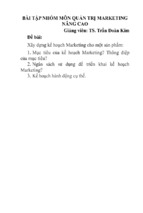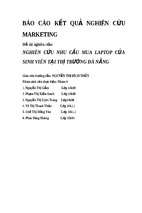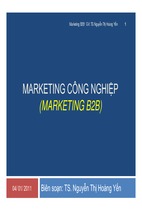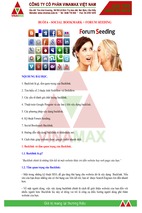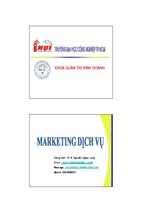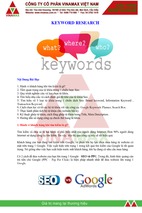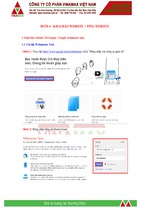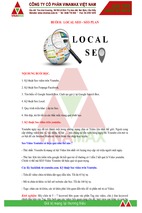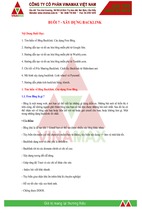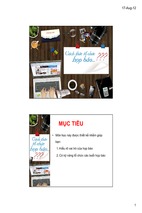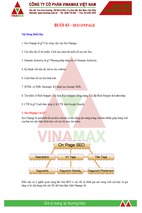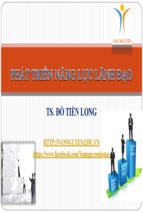HOW TO
CAPITALIZE
ON THE
CONTENT MARKETING
CONTINUUM
HOW TO DESIGN
MARKETING-TO-SALES
PROGRAMS FOR THE NEW BUYER
By Ardath Albee
Capitalize on the Content Marketing Continuum
Continuum – noun; A continuous extent, series or whole
- Dictionary.com
Marketing is no longer effective when comprised of one-off events, messages or campaigns. The buying experience during a
complex sale must be fluid, connected and engaging across its entirety. Content marketing programs are the threads that weave
together to create a fabric of engagement that elevates pipeline velocity, putting salespeople in viable opportunity conversations
sooner—rather than later.
There are no stops and starts in a continuum. The flow is consistent, steady and designed to build the problem-to-solution story
with buyers by providing the education, expertise and evidence they need to conclude that your company is the ultimate choice to
help them achieve business objectives. This eBook is your guide for generating a transformation in marketing, from standalone
efforts into strategic business assets that improve revenue performance.
2
©2012 Marketing Interactions, Inc.
Capitalize on the Content Marketing Continuum
Table of Contents
Get Up to Speed..........................................................................................................................................................................................................4
Online Publishing Changes the Game.................................................................................................................................................................5
How Online Publishing Affects Buyers.................................................................................................................................................6
How to Rise Above the Online Noise......................................................................................................................................................7
Tools to Increase Relevance.....................................................................................................................................................................................8
Buyer Personas...........................................................................................................................................................................................11
Five Steps to Building a Buyer Persona.............................................................................................................................................. 12
Four Types of Prospect Attention........................................................................................................................................................ 13
The Importance of Integrating Marketing Channels.....................................................................................................................................14
Why Segmentation Marketing is the New Black............................................................................................................................................ 15
How and Why to Narrow Your Focus...................................................................................................................................................16
Messaging to Multiple Target Segments.............................................................................................................................................17
Design Content Flows for Target Segments.......................................................................................................................................18
How to Improve the ROI on Marketing Content Investments...................................................................................................... 19
Shifts in Skills Needed to Market to the New Buyer...................................................................................................................................... 20
Creating Synergy with Sales................................................................................................................................................................................. 26
Producing Leads Worthy of Sales Pursuit......................................................................................................................................... 27
Why the Toss Over the Wall is OUT and the Baton Pass is IN...................................................................................................... 29
Give Sales a Conversational Toolkit.................................................................................................................................................... 30
Position Salespeople as Valuable Experts.......................................................................................................................................... 31
Capitalize on the Content Marketing Continuum......................................................................................................................................... 32
About the Author.................................................................................................................................................................................................... 33
3
©2012 Marketing Interactions, Inc.
Capitalize on the Content Marketing Continuum
Get Up to Speed
The buyer has taken control of the purchasing process; it’s a refrain heard often in marketing and sales channels. Information
has become ubiquitous—as has access to it. No longer are companies and their salespeople the gatekeepers that must be sought
out for help to assuage curiosity, reveal solutions to problems, build business cases and select a short list of vendors to pursue.
The informational gatekeepers are now represented by search engines, social networks and perceptions of relevance. Marketers
and salespeople are now reliant upon their ability to:
• Be found with the right information in the channels buyers prefer
• Attract and keep the attention of buyers and influencers
• Respond appropriately with digital dialogues that motivate buyer intent
• Elevate the perceived value of every interaction—whether with marketing or sales
What the continuum means for marketers
Marketing has become a continuous stream—not one-off campaigns or events. This creates a continuum that must be sustained
by stripping away the pretext, posturing and limitations of traditional company and product-focused marketing. A continuum
approach is based on delivering escalating value for buyers in every online interaction to create digital dialogues that drive
momentum that results in sales and continues on across the entire customer lifecycle.
Implications for sales
Where the continuum intersects with sales, the provision of value-added, fresh and relevant ideas must seamlessly transition
without interruption to momentum. Salespeople must be primed to provide unique expertise beyond what competitors can
even imitate—should they try.
Preparing for the Content Marketing Continuum
The ability to publish content online, interact with buyers and engage in social conversations has become simple to execute. It’s
the planning, strategy, and context—along with a foundation for sustaining it consistently over time—that challenges marketers
and salespeople. Shifting the dynamics of marketing requires new skills and ways of thinking. Following is a framework to help
you prepare for sustainable marketing and sales efforts that put the new buyer at the center of your strategy. Change is never
easy, but it can certainly be transformative. Ready?
4
©2012 Marketing Interactions, Inc.
Capitalize on the Content Marketing Continuum
Online Publishing Changes the Game
Speed is one of the dynamics of today’s marketing. The concept of real-time is pushing marketers to move more quickly than
they’ve ever moved before. Speed for marketing is a construct driven by the ease of publishing content and the rallying cries
of social media enthusiasts and so-called marketing gurus. The fear of missing out in the chase after the latest shiny object
developed to change the way people live, work and play—and most importantly, buy—is urging marketers to move faster.
This is not to say that it shouldn’t be an imperative to take advantage of these new capabilities, but that marketers need
to take a deep breath and consider the implications that come with online publishing, and how they change the game.
Online publishing is a rather broad concept. It covers every format for distributing
content online including, but in no way limited to, website content, articles, blog
posts, video, white papers, case studies, eBooks, social media profiles, company
pages on Facebook, LinkedIn discussions, forum questions and answers, webinars
and virtual events, Tweets, podcasts, images, slide decks, and the rapidly growing
use of infographics. Let us not forget that online publishing also includes processes
such as curating content and publishing press releases.
58% of buyers say thought
leadership from solution
providers is important or
critical during their buying
process.
48% said that if the quality
The concept of earned media has been enabled by online publishing. Earned
of thought leadership im-
media is often defined as what others choose to say about your company, but it
proved, it would influence their
should also be considered in relation to those who share your content with their
purchase decision.
networks. This includes content curators, community blog syndication and social
mentions. All types of earned media serve to extend the reach of your content
ITSMA and PAC, 2010
How Customers Choose Study, 2010
farther than you could on your own. Sharing transfers credibility from the
source with their recommendation that their audience will find it relevant to
their interests.
Rather than paying for content placement, marketers can now create their own
media and earn coverage in channels where that content is found valuable by
audiences they want to reach. But the biggest game changer of all may be the
ability for a company to create, own or sponsor online communities and websites
“
Adobe is the brand
behind [cmo.com], but
our job is not really to sell
product, but to educate and
inform the chief marketing
that facilitate the publishing of thought leadership content to help their target
officer about issues going on in
audiences deal with business priorities—without trying to sell anything. Among
the digital marketing world.
many examples are cmo.com, sponsored by Adobe, Smart Data Collective, sponsored by Teradata, and all Business, sponsored by D&B, and Bizmology, published
by Hoover’s.
5
©2012 Marketing Interactions, Inc.
Timothy Moran, editor in chief, cmo.com
Capitalize on the Content Marketing Continuum
How Online Publishing Affects Buyers
One of the misconceptions that comes with speed is that it’s an equal-opportunity dynamic. Just because marketers can publish
content quickly doesn’t mean that buyers will keep stride with this breakneck pace. The rise in content publishing assumes
that there’s a corresponding rise in the availability of time and attention needed to consume that volume of content. For
buyers, often the opposite is true. Marketers may be producing more content, but buyers often have less time to consume it.
Three factors that impact the buyer experience include how to:
1.
Find the right information – the overwhelming amount of
How buyers say they spend their
information available on every topic imaginable makes it more
time during their buying process:
difficult for buyers to filter it to determine which of it is credible,
or even useful. The time this takes is also extremely limited, slowing
the buying process regardless of how fast marketers think they’re
23% in discussions with colleagues
21% with sales team interaction
addressing buyers’ needs by publishing more information, faster.
19% searching the web
Even if it’s information they need.
19% with educational content
2.
Convince the right people – in a B2B buying process, the increase of
18% reviewing promotional
complexity and breadth of solutions requires more people to reach
content
consensus—each of them with differing priorities and motivations.
The content that works to convince one stakeholder to embrace the
IDG Connect, 2011
proposed change may not work to persuade the others.
3.
Build the best business case – today’s economic climate has changed
the usual budgetary structure, requiring buyers to identify problems, the reasons for solving them and—only once that
foundation has been established—to build a business case to secure the budget to proceed. Research by DemandGen
Report found that 30% of B2B purchases were made in this fashion by buyers surveyed. The challenge for marketers is
to provide information so clear and relevant that the value of pursuing the fix is validated by proof of the impact the
project can have on the company’s business objectives.
All three of these factors can be answered with online publishing, but to do so marketers must first plan for and address the
challenge of being found in the channels buyers prefer.
6
©2012 Marketing Interactions, Inc.
Capitalize on the Content Marketing Continuum
How to Rise Above the Online Noise
Being found by the right prospective buyers is dependent upon differentiation supported by specificity. The only way marketers
can do this well is by doing the work and research it takes to get to know their buyers nearly as well as they know themselves.
Here’s an example to demonstrate what I mean by differentiation and specificity in relation to providing content that will rise
above the noise for your buyers:
Take the concept of “growing revenues.” It’s something most companies tout as a benefit their buyers can get from using their
products and services. But it’s so generic and high level that, on its own, it means nothing interesting.
There are many ways to increase revenues. The key is to think about the how and the why instead of relying on the vanilla
benefit (the what).
Why is your prospect’s priority focused on increasing revenues?
• Perhaps it’s because he’s a line of business manager and his job depends
on the amount of product that gets sold in the marketplace.
• Maybe she’s the director of inside sales and her reps must provide field
sales reps with leads worthy of pursuit or the company won’t meet their
quota for revenues.
• Perhaps your prospect is a call center manager and his initiative is to
increase cross-sell and up-sell solution extension products to current
customers.
• It could be that your prospect is the CEO and responsible for increasing
Buyers’ top complaints about
content include:
33% say there’s too much
content that’s not useful
29% say content is not
relevant
24% say content does not
stock value for investors through continuous growth milestones the
meet the needs of all the
company must achieve.
people involved in the
decision
To each of these people, the concept of driving revenues has a different context.
The reasons supporting the goal are different. Their role and responsibilities
23% say there’s not enough
educational content
within the company are different. If you’re trying to reach all of these buyers with
the same content, it’s less likely to be found and assigned the attention required
to build and sustain engagement across the buying process.
7
©2012 Marketing Interactions, Inc.
IDG Connect, 2011
Capitalize on the Content Marketing Continuum
Now think about the how. How can the prospect best contribute to the overall objective of driving revenues?
• For the product manager, perhaps the solution is new packaging to make the product more appealing or improve
training for salespeople in how to sell it. Maybe it’s improved management of production to better meet demand.
• For the inside sales manager, a possible solution could be providing faster access to information that enables her reps
to have better conversations with prospects, improving quality and prioritization.
• For the call center manager, perhaps it’s improving the ability for her agents to easily know what products the
customer already has and which are appropriate add-ons or advances relevant to their business needs. This
could mean integrating data silos.
• For the CEO, perhaps the answer is better dashboards or information visibility that enables better and faster decisions
to be made for volumes of data.
When you can get specific enough to narrow your focus to the who, the why and the how that relates to the what (driving
revenues), then you can create messaging and content that rises above the noise to get found by your buyers. Once again,
the best way to accomplish this is to get to know your buyers.
When creating content with differentiation and specificity, make sure that it delivers on buyers needs by:
• Showing the reader why he should care at the start. Don’t bury your hook.
• Educating them with information they need to know about solving a specific problem.
• Making your call to action easy to understand and simple to respond to.
• Demonstrating the impact you promise in simple terms and show them where to find it.
• Igniting urgency on their part to learn more and take next steps because it seems like the natural outcome for them
after reading your content.
8
©2012 Marketing Interactions, Inc.
Capitalize on the Content Marketing Continuum
Tools to Increase Relevance
Engaging B2B buyers across the entirety of the purchasing process must be the goal of marketers. In today’s online business
environment, this means not only the ability to create digital dialogues, but to sustain them over the long term. By flipping
your focus from the way your company defines the sales process to how buyers engage in the buying experience, you’ll gain a
better understanding of how to make this happen.
Instead of orienting your funnel to a sales perspective, focus the stages of
The Buyer-Experience Funnel
the funnel on your B2B buyers’ experience. When your funnel is focused
stages include:
on meeting the needs of all the people involved in the decision, you’ll see a
swelling in the middle, instead of the constriction that indicates fallout, or
Interest: Get buyers to take a
leakage, in traditional funnels.
look at how you can solve the
problems they face.
In the buyer-experience funnel, notice the buyer/customer and marketing
Attention: Convince them to
are interwoven throughout the entire buying experience—and beyond.
opt-in. Fallout occurs if they
Salespeople enter the process around the 5th stage and are usually out of
choose not to continue.
Value: Instantly recognizable
value increases willingness
to engage.
Engagement: Prospects spend
more time & mindshare with
your content.
Buying committee involvement:
Your funnel swells as influencers
interact to gain consensus by
building and validating the
business case.
Conversations: Sales steps in to
drive momentum to purchase
based on interests expressed.
The funnel narrows to core
decision maker participation.
Purchase: Buyers choose to
partner with your company.
9
©2012 Marketing Interactions, Inc.
the equation after the buyer purchases. But most importantly, recognize the
expansion that happens in the middle of the buying process during buying
committee involvement. This is where knowing who else is involved in the
process—and addressing their interests—is critical to continuing the flow of
buying momentum. Today’s buyer experience is quite different from the
process most marketers have enabled and supported in the past.
Capitalize on the Content Marketing Continuum
A disconnect occurs because marketers haven’t changed in response to how their buyers have shifted. The figure below shows
how the majority of marketers are responding to the buyer experience according to a poll taken with attendees of the Sirius
Decisions Summit in 2011.
According to the poll, 79 percent of marketers are only addressing a fraction, if any, of the buying experience that’s pivotal to
generating the increased demand that leads to customer acquisition. This presents a huge opportunity for the marketers who
recognize and address the importance of addressing the variety of activities and needs that arise across the entire buyer
experience funnel.
The buyer experience funnel has a direct overlay to the stages of the buying process and the questions your prospects will
need answered as they move from stage to stage.
10
©2012 Marketing Interactions, Inc.
Capitalize on the Content Marketing Continuum
Buyer Experience
Buying Stages
Buyer Questions
Interest: I’m curious enough to take a
look.
Status Quo: Problem not yet recognized as painful enough to fix.
Why should I care?
Attention: I like what I see so far.
Priority: Problem recognized but unsure how to proceed.
What should I know?
Value: This can really help me achieve
goals.
Research: Actively engaged in learning what they need to know to take
action.
What are best practices?
Engagement: I need to find out more
about how they deliver what they
promise.
Options: Identifying solution sets that
can provide the most value for now
and future.
Who has the expertise?
Buying Committee Involvement:
Everyone needs to get on board.
Step backs: Stops to verify beliefs or
find answers to new questions.
What if…?
Conversations: I want to make sure I
can work with you – trust you.
Validation: Exploring evidence that
supports vendor promises.
Why should I believe you?
Purchase
Choice: Deciding to buy.
You’ll bring the most value.
In the table above, note the parallels between the buyer experience, stages in the process and the corresponding questions.
There’s a fluency of progression from the top to the bottom.
Buyer Personas
To coordinate the experience, stages and questions into a consistent process that meets the needs of your buyers, use buyer
personas as the foundation. Personas do not need to be difficult, but they do require that you step into the shoes of your target
market to create them.
A persona is a composite sketch of a type of customer your company serves.
When creating a persona, it’s best to focus it on one segment with one problem-to-solution journey. If you focus more broadly, it’s
hard to tell a consistent story that builds momentum over time. Once you’ve used the problem to define scope, decide who the
issue is most important to and begin to build your persona following these five steps.
11
©2012 Marketing Interactions, Inc.
Capitalize on the Content Marketing Continuum
Five Steps to Building a Buyer Persona
Step 1: Define their current situation
• What is their priority and what do they do or use to achieve
Use Business Intelligence
their goal today?
Portals:
• What workaround(s) could be in place?
• Search by industry, size, title.
• What problem is limiting their success?
• Assess profiles, click through to
review LinkedIn profiles.
• Use at least 20 profiles to
Step 2: Define their demographics
• Job Title(s)
• Years in current position and place in career – whether they’re young
and just starting or have spent most of their career with the same
company can provide insight on risk tolerance, influence in
creating change within the company, etc.
• Company size and revenues
• Industry
identify common themes.
• Access the industry information
to gain insight to challenges and
opportunities.
• BI portals also offer in-depth
research on specific industries,
helping you to define priorities
and challenges quickly.
Talk to Salespeople:
Step 3: Identify their attributes
• Role – Their place in the company and who they answer to.
• Responsibilities – What or who they manage and what outcomes they
• What areas of the business are
they focused on?
• Who are they speaking with?
• How do prospects frame the
must achieve.
problem?
• Threats – what could derail the deal?
• What stops them from taking
• Motivations – both professionally and based on company objectives –
could also be what they want to avoid.
next steps?
• Who else do they have to
convince?
• Influencers – who can aid in affirming the project or stall it from
moving forward?
Talk to Customers:
• What problem did we solve?
Step 4: Understand their preferences
• Where do they spend time online? Offline?
• How do they participate with social media? Do they?
• What keywords, phrases and search terms resonate with them?
12
©2012 Marketing Interactions, Inc.
• What else did that enable?
• Why did they choose us?
• What obstacles did they have to
overcome to buy?
Capitalize on the Content Marketing Continuum
Step 5: Draft the buyer persona value statement
• I need to solve (problem)____________in order to achieve (solution/goal)___________.
Four Types of Prospect Attention
Attention is the capacity to maintain selective or sustained concentration. The amount of attention your prospects attribute to
your digital dialogue will be indicative of their propensity to buy from your company. But, it’s important to consider that not
all the types of attention are the right kind of attention to contribute to purchase decisions.
As you create content marketing strategies to provide a better buying experience,
consider which types of attention you could be generating and how only one type
Catch Factors are the
will truly influence purchase decisions.
preferences and aversions
that form a prospect’s gut
1. Cursory attention – This attention is the equivalent of curiosity in the
Interest stage of the buyer experience funnel. This is your buyer telling you
reaction to your content and
communications.
Urgency: Is it a priority
that he or she may be interested in what you have to say, but they are thus
right now?
far unconvinced of how much of their time your content and dialogue
Effort: How hard will it be to
warrants. This is status quo and where you start.
access, understand and use the
information?
2. Misleading attention – The buyer thought he was interested, but his
attention wandered and he may possibly still be staring at your content,
but thinking that he needs to pick up his dry cleaning on the way home
from work and wondering what his wife is cooking for dinner. This
attention can also be from people who want a content offer for the
information it promises, but not because they’re interested in buying
from you.
13
©2012 Marketing Interactions, Inc.
Reputation: What do I know and
think about your company?
Intent: What do you want
from me?
By addressing Catch Factors
within your content, you will
not only catch, but keep,
attention across the buying
process, transitioning it from
cursory to intentional attention
that turns prospects into buyers.
Capitalize on the Content Marketing Continuum
3. Voluntary attention – These are the people who subscribe to everything you publish. They read your blog, sign up to
attend webinars, but always stop short of taking a next step that would indicate momentum in the buying process. This
said, this is the type of attention that results in earned media, referrals and advocates, so it’s wise to cultivate it.
4. Intentional attention – BINGO! This is the type of attention you want to achieve. These are the buyers who are intent on
learning what they need to know to make a purchase decision. They interact purposefully with your content and
proactively access it, even without prompting from nurturing emails. You can see a pattern in the content they’re
accessing and the dialogue they participate in, or follow. These are the buyers that will invite sales into conversations
when they reach that stage in their buying process.
The Importance of Integrating Marketing Channels
With the increasing comfort B2B buyers have for sourcing information online and participating in social media—not to
mention using search engines—the quality of your digital dialogue must be impeccable. It’s imperative that your content
marketing programs show buyers the consistency and expertise that demonstrates the traits of a partner they’d choose
to help them solve their highest-priority problems.
Online publishing has enabled marketers to expand the distribution channels they use to share content and reach buyers.
Unfortunately, the norm is that these channels are executed as silos, rather than as one comprehensive program. Sometimes this
is due to how marketing tasks are distributed across the company. Sometimes it’s simply that no strategy exists to execute
channels in sync with overall objectives and goals.
This needs to change. And change quickly.
When’s the last time you typed
your company’s name into a
Let’s say that your company has a website, an expertise micro-site, a company
blog, several employees who both Tweet and blog personally, a group on LinkedIn,
a YouTube channel and nurturing programs designed to engage three different
personas. These channels are executed by three different marketing groups;
demand generation, web marketing and social media.
14
©2012 Marketing Interactions, Inc.
search engine?
What about the keywords and
phrases your buyers use?
Have you experienced your
marketing programs as your
buyers do?
Capitalize on the Content Marketing Continuum
How likely is it that each of these three marketing groups knows what the others are doing? The reality is that prospects will
traverse a variety of channels during their research for problem solving. They’re likely to encounter content and dialogue
placed online by each of the three groups. Will their experience be consistent? Or will the contrast be so fragmented that these
experiences culminate with a diminishing level of interest in doing business with your company?
Each channel requires a unique format, tone and style of content. The key is to make sure that the message experience is
consistent, encouraging a higher level of engagement and intent.
Why Segmentation Marketing is the New Black
In every client engagement, I have yet to find only one persona, or target market. Most companies have at least two or three
audiences that must be addressed for each solution. Addressing those audiences based on their specific needs and interests is
usually constrained by marketing resources, rather than due to prospect similarities.
Segmentation must reach beyond job titles and industry to incorporate the knowledge gained from creating personas.
Unfortunately, as you’ll see in the chart below, research from Marketing Sherpa finds that segmentation is still a top
relevance challenge for marketers.
The purpose of segmentation is to match
content with the interests and needs of the
audience. Ultimate segmentation is when
marketers can implement strategic responses
based on behavior, rather than just a category
such as role, title or industry. High relevance
directly correlates to level of engagement.
As you can see in the chart, segmentation and
interactions based on behavior, triggers and
place in the sales (buying) cycle are three of
the top four challenges stated by marketers
that keep them from improving the perception
of relevance by their prospects.
15
©2012 Marketing Interactions, Inc.
Capitalize on the Content Marketing Continuum
It’s also important to realize that segmentation is not just for email campaigns. It applies to how marketers address each
audience they wish to engage. Consider new forms of segmentation that marketers can use:
• Hashtags on Twitter for specific interests
• LinkedIn Groups
• Participation on topic-driven community sites
• Categories and tags on company-owned blogs
• RSS feeds for specific topic areas on websites
How and Why to Narrow Your Focus
Segmentation can also be thought of in terms of a niche.
86% of respondents say
“A niche, by its very nature, catches the attention of those it appeals to.
customer engagement is
These people are the ones who will go out of their way to participate
essential or important – down
and interact with it. And with others who have the same interests.
2% from last year.
You’ll find it easier to generate relationships because your
communications and content relevance will be so high they will spawn
However, only 6% say that they
interactions based on the establishment of a common foundation for
know all of their customer
dialogue. And a niche focus increases your prospects’ view of your
touch-points and 34% say they
company as a specialist with expertise they need. This is because you
don’t know how many customer
are perceived to be focused solely on them.
touch-points they have.
“Think about the beauty (and the potential payoffs) of a niche. Niches
eConsultancy,
Customer Engagement Report, 2011
come to life when you add personas. A persona takes a segment of your
company’s aggregate customer profile and fleshes it out with detailed
information that represents real prospects in specific circumstances.
The more specific you can get about the boundaries of your niche, the
more your persona can become a viable representation of your
53% of marketers say their
prospective customers. Consider as a simple example of narrowing to a
primary concern is meeting the
niche focus that “all people who drive SUVs” is not the same market as
growth agenda by establishing
“those who drive Hummers.” And remember that a niche is different
a differentiated brand position.
than a persona. One niche can have a variety of personas. You would
market differently to female buyers of Hummers than to men who drive
Only 10% ranked their
hummers, for example. Or, a Director of IT will have different interests
organizations well equipped to
than a CIO.”
target customers and market
to them in innovative ways.
Excerpt from eMarketing Strategies for the Complex Sale
Prophet’s 2011 State of Marketing Study
16
©2012 Marketing Interactions, Inc.
Capitalize on the Content Marketing Continuum
Payoffs from narrowing your focus include:
• Higher engagement, interest and dialogue
• Increased momentum across the buying process
• Getting buyers to involve salespeople earlier in the conversation
• Competitive advantage based on increased credibility and trust
Messaging to Multiple Target Segments
According to DemandGen Report, 43.7% of buyers say they’re taking more time to research purchases. This is likely related to
research by IDG Connect that finds 62% of buyers say the content they find is not relevant or useful.
To get the feel for how messaging is refined to address specific target segments, take a look at how Apple has created successful
engagement across four segments, excerpted from Prophet’s 2011 State of Marketing Study:
Notice the differences in the positioning message for each segment:
Consumers: “Devices should help you experience your life exactly the way you want to.”
App Developers: “You can be part of the future, have an impact on people’s lives, and generate value
along the way.”
Media companies: “Your business will thrive and your content will be experienced better than ever before.”
Tech bloggers: “You win when you make the future understandable to the masses.”
Each of these messages, while specific to a target audience, carries the style, tone and passion of the Apple brand. The messages
focus on a want, need and priority for each segment. With each of these positioning statements, Apple can match them up
against all the content and messaging developed for each segment to ensure that the messaging stays on point, delivering high
relevance with each interaction and dialogue.
Consider the potential differences in priorities between sales and operations as another example. Salespeople are focused
on driving revenue and increasing customer acquisition. Operations managers are concerned about increasing profits,
which usually translates to reducing bottom-line expenses. Revenue is not the same as profit and requires a different message.
Reducing bottom-line expense is often about process efficiency. Increasing revenues is based on the effectiveness of salespeople
to create high-value perception coupled with low risk for buyers to help them make a purchase decision in your
company’s favor.
17
©2012 Marketing Interactions, Inc.
Capitalize on the Content Marketing Continuum
Design Content Flows for Target Segments
A content flow is the storyline marketers must create to engage a prospective
buyer over the course of their buying process by providing the right
information at the right time. Think about how you go about buying something beyond a transactional purchase today. It’s likely that the first place you
Segmented emails garner 50%
more clicks than general mass
email blasts.
turn to is an online search to learn more about your options. This is also true
Marketing Sherpa
for your buyers.
What marketers fail to understand is that search queries are the digital
version of a question and answer session. Each query is based on a question the buyer is seeking information to answer. Once
one answer has been found, the path is cleared for the next question, and so on.
Content marketing storylines based on this type of ebb and flow will get found, create engagement and qualify leads.
Determining the questions your buyers have during their buying process will help you to create content that answers those
questions—increasing relevance.
Let’s say we’re a customer analytics software company constructing a content flow for customer service executives of large
telecommunications companies. Below is an example of the types of questions prospects may have and ideas for content that
might address them.
18
Questions (priorities)
Answers (content premise)
Why is first-call-resolution eroding?
The increasing complexity of service calls for customers with
multiple devices.
How can I increase customer satisfaction?
The power has shifted: how to answer the needs of today’s mobile
and social customers.
How can my team reduce truck rolls?
Skills for better remote problem diagnosis.
How can we better handle spikes in volume due
to new product launches?
Advance planning strategies for staffing in response to product
launches in telecom.
What can I do to improve cross sell and up-sell
across product lines?
Give your customers what they want – even if they don’t know it yet.
What information can I produce to help the
company better connect with our customers?
How a reporting dashboard helps you analyze data to extract
actionable insights quickly.
What KPIs should I be monitoring to improve
customer loyalty?
Today’s customers switch on a dime – 5 new metrics for loyalty and
how to use them.
©2012 Marketing Interactions, Inc.
Capitalize on the Content Marketing Continuum
Every question that your buyers have can be answered directly with a content
asset. Discovering all the questions they will need to answer during their
buying process should be part of the persona development process. When
Top 3 Marketing Challenges
• Lack of budget, time and
buyers find answers to the questions they have about resolving high-priority
resources (62%)
issues, they develop confidence that helps them to take next steps, increasing
• Inability to stop executing and
momentum toward purchase due to a compelling buying experience.
think strategically (39%)
• Limited ability to develop
What becomes evident quickly is that the amount of content it takes to develop
programs for a number of target segments to meet the needs of both buyers
and influencers can add up to a mountain of assets. With limited resources,
content (35%)
Marketing Sherpa
2011 B2B Marketing Benchmark Survey
marketers must get creative to extract more value.
How to Improve the ROI on Marketing Content
Investments
Content must be considered an investment rather than an expense. In order for that to be true, marketers must learn how to gain
more output from their content development processes and make wise choices about how content assets can provide extension
uses beyond the original goal for the development of each asset.
Here are three ways to get more from your content:
• Reinvention. Content that currently exists must be audited and re-imagined to provide coverage in more than one
channel. Often, marketers will create a big asset – such as a white paper, use it once in a lead generation campaign and
then relegate it to the resources section of the corporate website. With all the new channels in the marketing mix,
marketers can use that white paper for much more. For example:
• Pull a chart used in a white paper and write a bit of commentary addressing the findings and post it to the
corporate blog. Link back to the white paper to encourage more downloads.
• White papers are usually written in sections. Pull each section and turn it into a standalone article.
Use the articles as a series for a nurturing program or in your monthly newsletter.
• Tweet with a related #hashtag to expand the reach of the white paper.
• Use the white paper to create a slide deck you can share on Slideshare as well as embed in a blog post or a
19
related section on the corporate website.
• Create another version of the slide deck to host a webinar on the topic covered.
©2012 Marketing Interactions, Inc.
Capitalize on the Content Marketing Continuum
• Repurposing. As has been discussed previously, content is more effective when its focus is narrowed to address
the needs of one target segment. What may not be readily apparent is that there may be overlays across industries
or segments.
• Take a look at your persona—or target segment—questions to see if versions of the same question are asked by
different personas. It may be that a content asset designed for one persona can be quickly revised to address
the version of the question asked by another.
• Many companies address the same target audience in a variety of vertical industries. Make the appropriate
changes to the content to position it for each additional industry where it applies. I will caution you that just
changing the references to the industry is not enough. Make sure to address the subtle differences and
phrasing that expresses your understanding of each industry and audience.
• Repetition. Using the ideas shared in your content more than once is how
marketers should frame the context for repetition. New ideas take time to
take hold.
What Repetition is Not:
• Using the same piece of
Here’s a basic example: Let’s say the main idea is “The expectations of the new
buyer.” The original idea is to write an article about how the buyer has changed,
backed up with industry statistics and examples that are relevant for the
target market you’ve selected.
content over and over.
• Saying the same things
everyone else in your market
is saying.
• Using the same self-serving
calls to action (Schedule a
To put repetition into play, determine other ways to spin this main idea. Examples
demo today!)
might include:
• 10 reasons you need to change what you’re telling buyers
• Why your customer’s trust level has declined
• How to have a conversation with today’s buyer
• What sales needs to close the new buyer
Now you have 5 topics based on one main idea that you can develop into marketing content using the same research you’ll do
to develop the content asset around the main idea. All with a different take or spin, each one reinforcing your expertise on
the topic.
Shifts in Skills Needed to Market to the New Buyer
Making the shift from static B2B marketing to dynamic B2B eMarketing not only requires the appropriate technology and
tools, but a change to the marketer’s mindset. Companies are recognizing there are differences to be addressed as they realize
the power has shifted from their companies to their buyers. The Internet has unleashed a torrent of information, changing
forever the ways in which complex sales are conducted. To reach and engage the new buyer, marketers must develop and tune
20
©2012 Marketing Interactions, Inc.
- Xem thêm -


